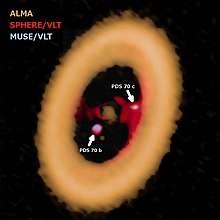Circumplanetary disk
A circumplanetary disk (or circumplanetary disc) is a torus, pancake or ring-shaped accumulation of matter composed of gas, dust, planetesimals, asteroids or collision fragments in orbit around a planet. Around the planets, they are the reservoirs of material out of which moons (or exomoons or subsatellites) may form. Such a disk can manifest itself in various ways.

around exoplanet PDS 70c
In August 2018 astronomers reported the probable detection of a circumplanetary disk around CS Cha B.[1] The authors state that “The CS Cha system is the only system in which a circumplanetary disc is likely present as well as a resolved circumstellar disc.”[2] In 2020 though, the parameters of CS Cha B were revised, making it an accreting red dwarf star, and making disk a circumsterllar.[3]
In June 2019 astronomers reported the detection of evidence of a circumplanetary disk around PDS 70b[4] using spectroscopy and accretion signatures. The latter were also detected for other planetary candidates before. In July 2019 astronomers reported the first-ever detection using the Atacama Large Millimeter/submillimeter Array (ALMA)[5][6][7] of a circumplanetary disk.[5][6][8] ALMA studies, using millimetre and submillimetre wavelengths, are better at observing dust concentrated in interplanetary regions, since stars emit comparatively little light at these wavelengths, and since optical observations are often fraught with overwhelming glare from the bright host star.
The circumplanetary disk was detected around a young massive, Jupiter-like exoplanet, PDS 70c; another such disk may have been detected around the related massive, Jupiter-like exoplanet, PDS 70b, as well.[5][6][8] These exoplanets are part of the multiplanetary PDS 70 star system, about 370 light-years (110 parsecs) from Earth.[9]
According to Andrea Isella, lead researcher from the Rice University in Houston, Texas, “For the first time, we can conclusively see the tell-tale signs of a circumplanetary disk, which helps to support many of the current theories of planet formation ... By comparing our observations to the high-resolution infrared and optical images, we can clearly see that an otherwise enigmatic concentration of tiny dust particles is actually a planet-girding disk of dust, the first such feature ever conclusively observed.”[7]
See also
- Accretion disc
- Circumplanetary dust
- Circumstellar envelope
- Disrupted planet
- Extrasolar planet
- Formation and evolution of the Solar System
- Nature timeline
- Protoplanetary disk
References
- Ginski, Christian (August 2018). "First direct detection of a polarized companion outside a resolved circumbinary disk around CS Chamaeleonis". Astronomy & Astrophysics. 616 (79): 18. doi:10.1051/0004-6361/201732417.
- Starr, Michelle. "Astronomers Have Accidentally Taken a Direct Photo of a Possible Baby Exoplanet". Retrieved 10 October 2019.
- CS Cha B: A disc-obscured M-type star mimicking a polarised planetary companion, 2020, arXiv:2007.07831
- Christiaens, Valentin (June 2019). "Evidence for a circumplanetary disk around protoplanet PDS 70 b". The Astrophysical Journal Letters. 877 (2): L33. arXiv:1905.06370. doi:10.3847/2041-8213/ab212b.
- Isella, Andrea; et al. (11 July 2019). "Detection of Continuum Submillimeter Emission Associated with Candidate Protoplanets". The Astrophysical Journal Letters. 879 (2): L25. arXiv:1906.06308. doi:10.3847/2041-8213/ab2a12.
- Blue, Charles E. (11 July 2019). "'Moon-forming' Circumplanetary Disk Discovered in Distant Star System". National Radio Astronomy Observatory. Retrieved 11 July 2019.
- Carne, Nick (13 July 2019). "'Moon-forming' disk found in distant star system - Discovery helps confirm theories of planet formation, astronomers say". Cosmos. Retrieved 12 July 2019.
- Boyd, Jade (11 July 2019). "Moon-forming disk discovered around distant planet". Phys.org. Retrieved 11 July 2019.
- Mandelbaum, Ryan F. (12 July 2019). "Astronomers Think They've Spotted a Moon Forming Around an Exoplanet". Gizmodo. Retrieved 12 July 2019.
